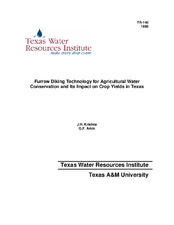| dc.description.abstract | Furrow diking is a practical, efficient and low-cost technique to conserve water and increase crop yields. Improvements in diker design and the increased use of herbicides have resulted in the rapid spread of furrow diking in the Texas High Plains and other regions.
To quantify the long-term effects of diking on crop yields, a computer simulation approach was used. Three crop models for sorghum, corn and cotton were combined with surface runoff hydrology algorithms, based on the USDA-SCS curve number methodology. The combination models called SORDIKE, CORDIKE and COTDIKE were run to determine the effects of conserving the runoff (by diking) on crop yields. Three scenarios of not diking, diking in the growing season, and diking all year were simulated. Daily weather data for 25 years from five Texas regions were used for the analyses. Depending on the location, furrow diking in the growing season increased average annual sorghum yields by 320 to 570 kg/ha, corn yields by 180 to 570 kg/ha, and cotton lint yields by 10 to 20 kg/ha. Diking the land throughout the year increased mean annual yields by 440 to 1080 kg/ha of sorghum, 210 to 800 kg/ha of corn and 10 to 30 kg/ha of cotton lint. The study indicated that furrow diking can be a valuable management practice for about 3.4 million ha of cropped area in the semi-arid and sub-humid regions of Texas. The practice may be useful in other areas also, to mitigate the effects of short duration moisture stress on crop yields. | en |


